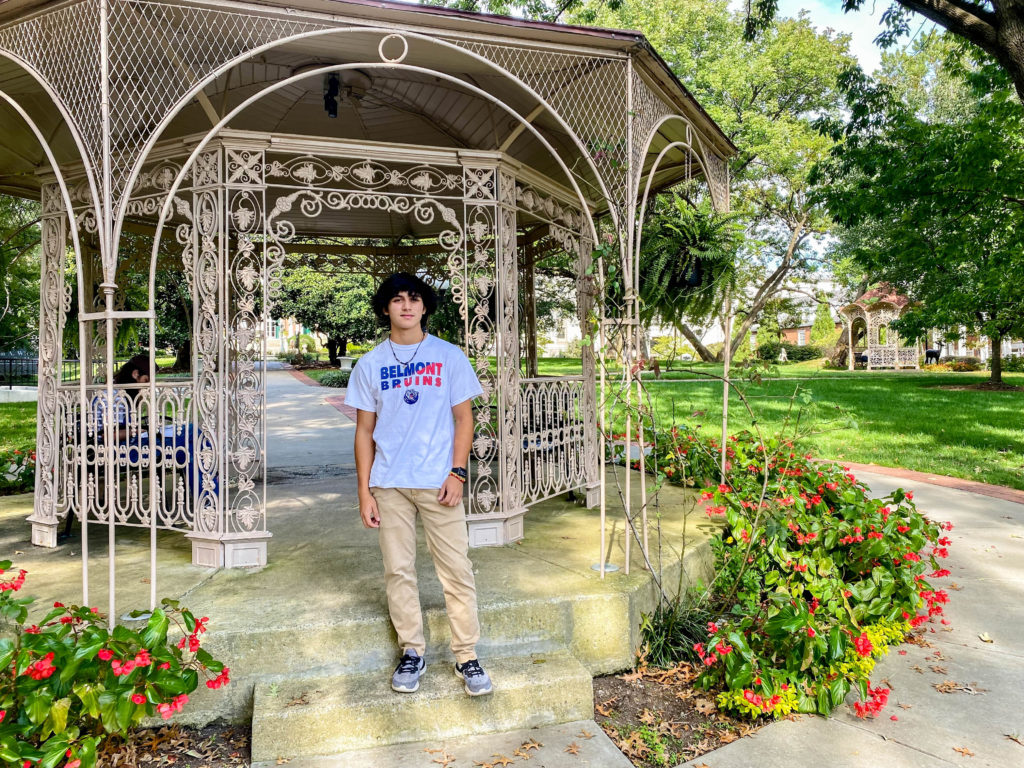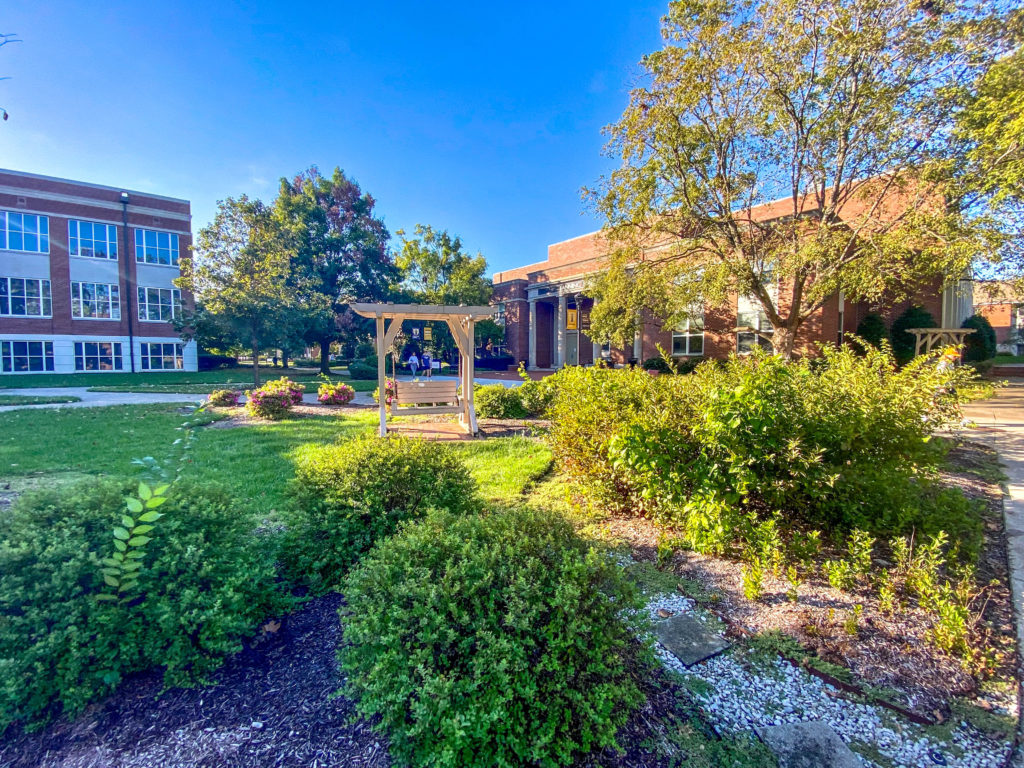
When Daron Baltazar immigrated to the U.S. from Mexico with his parents at five years old, things were looking up for his family.
They started off in Smithville before moving to Nashville around his seventh-grade year.
“And then about my early sophomore year, they divorced,” he says.
After the split, Baltazar’s mom and younger brother moved back to Mexico. He planned to go with them, but his mom wanted him to finish his education at Stratford STEM Magnet High School in Inglewood.
So, they took a risk, and Baltazar ended up staying with his best friend’s family instead.
“They adopted me, took me in, so I could keep going to Stratford,” he says.
Baltazar eventually got involved with the First Horizon Foundation Success Generation program and Martha O’Bryan Center, which runs a student union at Stratford.
 Damon Mitchell WPLN News
Damon Mitchell WPLN NewsBelmont University is one of many faith-based, private colleges in Middle Tennessee, and in recent years, it’s one of the schools publicly focusing finances and outreach efforts on diversifying its student population.
The groups helped him get accepted into Bridges to Belmont, a full scholarship program that was in part launched to increase ethnic diversity at Belmont University — by recruiting students from Metro Nashville Public Schools.
Baltazar is now a freshman majoring in finance and computer science at Belmont.
“I was one of the lucky ones that got through the whole process and got accepted,” he says. “And they’re actually planning on improving that to get more outreach to kids that are a minority.”
Outside of the support he gets from the Bridges to Belmont program, Baltazar says, the university also has a Hispanic Student Association. He says the organization helps him and other Latino students create a sense of community on campus.
“When we listen to what those students’ needs are, we’re going to provide the networks and the support services that those populations are going need — which could very well be unique from one group to the next,” says Chris Gage, Belmont’s enrollment dean.
 Damon Mitchell WPLN News
Damon Mitchell WPLN NewsOn Belmont’s campus, Latino students find community within their scholarship cohorts, if they’re a recipient, and through culture-specific groups, like the Hispanic Student Association.
Latino enrollment on private college campuses
In Tennessee, there are all sorts of barriers for Latinos who want to go to college. Many higher education institutions lack a sense of culture or belonging, and just aren’t doing enough to open their doors to these students.
There are some colleges, however, that have been making noticeable efforts to increase Latino representation on campus.
Belmont University is one of them. In the past five years, it’s grown its Latino population from 389 to 616 students, according to the school. Chris Gage says one reason for the boost is the Bridges to Belmont scholarship program. Recently, it’s expanded to 10 Nashville high schools.
“We’re also, as part of that program, hiring for an assistant director for admissions to focus specifically on access, equity, diversity and inclusion,” Gage says.
The university, he says, also launched a Latino engagement task force. It’s developing strategies to engage parents and recruit even more students, as well as Latino staff and faculty members.
Belmont has also hired a Spanish-speaking admissions counselor and developed partnerships with groups like Conexión Américas and YMCA Latino Achievers.
“And we just talk about it on a daily basis,” Gage says. “We look at dashboards; we look at reports that kind of point to whether or not we’re moving the needle with these specific populations.”
But Belmont isn’t the only college that’s had success growing its number of Latino students.
 Damon Mitchell WPLN News
Damon Mitchell WPLN NewsThe sun brightens a section of a landscape design near Lipscomb University’s Bennett Campus Center.
Lipscomb University, another private college, is having its own success increasing the number of Latinos on campus.
This fall, nearly one in 10 Lipscomb students now identify as Latino — the highest it’s ever been. In comparison, Latinos make up about 14% of Nashville’s population.
“By recruiting students at high schools that may have a higher percentage of Hispanic/Latino students, reaching out into the community to communicate effectively about the value that a Lipscomb educational experience provides, and working to make a Lipscomb educational experience affordable, we have been able to help students see themselves here,” Lipscomb’s chief enrollment officer Byron Lewis said in a statement to WPLN News.
 Courtesy Lani Perez-Santana
Courtesy Lani Perez-Santana Lani Perez-Santana
Lani Perez-Santana is a Mexican-American sophomore in Lipscomb’s education program. She says going from one of Tennessee’s most ethnically diverse high schools — John Overton — to Lipscomb was a rough transition.
“When I came to Lipscomb, my first class was very difficult,” she says. “I felt like a fish out of water.”
Lipscomb is a historically white Christian college, and it isn’t exactly at top-of-mind for high schoolers who want a place to celebrate their Latin culture.
Perez-Santana came to the college ahead of the country’s divisive 2020 presidential election. But she eventually found a sense of community through Lipscomb’s Pionero Scholars Program. The scholarship provides support to Nashville students who want to teach in the Metro school district. Many recipients identify as Latino.
“And there’s also an office of intercultural development here,” she says. “So, if I ever feel lonely or just isolated, I can always go in there to definitely feel my roots.”
Then, there are student organizations like Raíces, which was launched last spring. It recently held an induction ceremony, including music, socializing and cake for new members.
 Damon Mitchell WPLN News
Damon Mitchell WPLN NewsRaíces leaders get ready to cut a cake to celebrate membership becoming official for newly joined students to the Lipscomb University group.
“It’s a really vivacious group. We represent many different countries of origin,” says Raíces vice president Isadora Koch. “And it’s just a great place to come together and celebrate Hispanic culture.”
 Caroline Eggers WPLN News
Caroline Eggers WPLN NewsIsadora Koch, far right, stands with Raíces board members at Lipscomb University’s Bennett Campus Center.
Still, public universities remain the go-to for many
Even with recent strides, not all Latino students have access to private colleges like Lipscomb and Belmont.
Many private universities have tougher admissions standards than state colleges. So, students who aren’t good test takers or didn’t perform extremely well in high school may not be able to get in.
Some Latino students, like Gerson Solis at Middle Tennessee State University in Murfreesboro, also say the colleges aren’t affordable.
“My family doesn’t have the best income. What we could afford with my scores, and GPA and ACT was MTSU,” he says. “They were offering us in-state tuition at the moment. It was all about affordability.”

